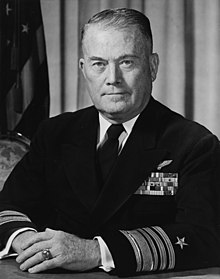William Raborn
| William Raborn | |
|---|---|
 |
|
| Director of Central Intelligence | |
|
In office April 28, 1965 – June 30, 1966 |
|
| President | Lyndon Johnson |
| Deputy | Richard Helms |
| Preceded by | John McCone |
| Succeeded by | Richard Helms |
| Personal details | |
| Born |
William Francis Raborn, Jr. June 8, 1905 Decatur, Texas, U.S. |
| Died | March 6, 1990 (aged 84) McLean, Virginia, U.S. |
| Education | United States Naval Academy (BS) |
| Military service | |
| Allegiance |
|
| Service/branch |
|
| Years of service | 1928–1963 |
| Rank |
|
| Commands |
USS Bairoko USS Bennington |
| Battles/wars | World War II |
| Awards |
Navy Distinguished Service Medal Silver Star |
William Francis Raborn, Jr., United States Navy (June 8, 1905 – March 6, 1990) was a United States Navy officer, the leader of the project to develop the Polaris missile system, and the 7th Director of Central Intelligence as well as the 5th Director of the Central Intelligence Agency.
Born in Decatur, Texas, he graduated from the U.S. Naval Academy in 1928. During World War II he directed the Gunnery Training Section at the Bureau of Aeronautics. He also served in the Pacific on aircraft carriers: Raborn was the executive officer of the carrier USS Hancock (CV-19) when her deck was damaged by a kamikaze attack. He had the deck repaired in four hours, allowing the ship's aircraft (which had been airborne when the kamikaze struck) to land safely - for this Raborn was awarded the Silver Star. He later commanded the carriers USS Bairoko (CVE-115) and USS Bennington (CVA-20).
Raborn was a rear admiral when he was appointed, on November 8, 1955, as Director of Special Projects at the Bureau of Weapons. His task was to develop a submarine-launched ballistic missile. He reported directly to Chief of Naval Operations Admiral Arleigh Burke and the Secretary of the Navy Charles Thomas. Raborn was told the new system had to achieve interim capability by early 1963 and full capability by early 1965. The USS George Washington (SSBN-598), the first ballistic missile submarine, was commissioned December 30, 1959, fired its first test missile July 20, 1960, and departed on the Navy's first deterrent patrol on November 15, 1960. Raborn received the Distinguished Service Medal and was appointed Vice Admiral in 1960. The same year he was awarded the Collier Trophy for his work on Polaris.
...
Wikipedia
